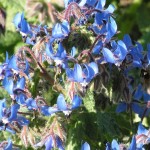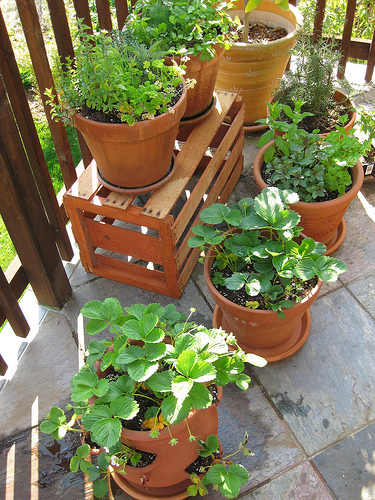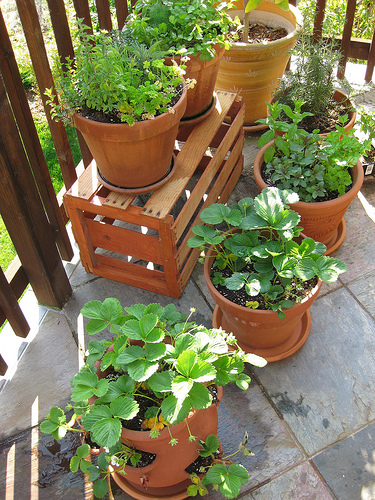The great thing about a container garden is that it can fit into just about any small space where there is sufficient sunlight (not less than 5 or 6 hours a day) and if you are forced to move, it can come right along with you. Container gardens can be grown on a windowsill indoors, but do best when out of doors on patios, balconies or even a sunny porch, as they do require good air circulation and indoor gardening has its own challenges with pests like white flies, aphids, etc.
The down side of containers is that they can dry out faster in hot weather or direct sun (which the vegetables need) if they are not really large containers, and if plants dry out regularly it will damage their roots and stunt the plant growth.
However, you cannot simply remove drainage holes or the plants will end up rotting in the pots – the water must be allowed to flow through and out when watering. (You can, however, use reservoir trays to help with this.)
Should you opt for a container garden to start there are several ways you can go.
Generally, if using standard flower or garden pots, you’ll need 16 to 22 inch diameter depending on the vegetables you choose. This is because vegetables need adequate space for their root systems, and will do poorly if roots are crowded. Squash and cucumbers need the most root space, followed by tomatoes, eggplants and peppers. For all of these vegetables a 22 inch diameter flower pot shape is a minimum container size to keep in mind. Peas, onions, carrots, beans and herbs all can do well in 16 inch diameter equivalent container sizes. That translates roughly to a minimum of 3 to 4 quarts of soil for the first group and 2 to 3 quarts for the second.
Herbs can do with considerably smaller pots, and greens, which have shallow roots, can be grown in shallower or flatter containers than typical garden pot sizes.
Tip: Do not use commercially available decorative planters unless they have adequate drainage. Most do NOT.
Rules of thumb for good container candidates:
- No drainage? No go – unless you can add holes.
- Flat bottoms with holes for drainage need to be raised up off cement or they won’t drain properly.
- Plastics and ceramics are fine.
- Wood should NOT be any type of treated lumber (toxic chemicals leach into vegetables).
- Redwood and cedar will last longer (rot resistant) if you are willing to spend the money to buy wood for building planters.
- Untreated scrap lumber is fine so long as it has no finish (varnishes or stains or paint). It won’t last as long as redwood or cedar but if it’s free that’s okay, right?
What can I plant in a container garden?
- Tomatoes (dwarf or compact bush varieties are best)
- Beets
- Bush Beans
- Cabbage
- Carrots
- Chard
- Green Onions
- Peas
- Peppers
- Salad greens
- Spinach
- Radishes
- Summer Squash
- Herbs (basil, borage, dill, lavender, parsley, rosemary, sage, savory, thyme)
 Tip: Plant herbs in among the vegetables in the container garden; particularly flowering herbs like borage, pennyroyal, thyme, basils, mints and savory and you’ll get more produce because you will also be attracting pollinators and achieving the benefits of companion planting vegetables and herbs.
Tip: Plant herbs in among the vegetables in the container garden; particularly flowering herbs like borage, pennyroyal, thyme, basils, mints and savory and you’ll get more produce because you will also be attracting pollinators and achieving the benefits of companion planting vegetables and herbs.
Tip: Borage is a huge bee attractor so you may want to plant the seeds in their own pot, they do NOT transplant well and they can get very large, with beautiful blue flowers. One borage plant in a container in the midst of your container garden will bring plenty of bees.
What should I use for soil?
A mix of compost and potting mix in a ratio of 1 part compost to 2 parts potting mix will give the plants what they need to get started. If you have extreme heat or dry summers consider adding vermiculite which will hold moisture or moisture gel crystals these will keep the soil from drying out too quickly.
Tip: Replace peat moss with coir in potted vegetables for a less acidic pH (coir’s pH is almost ideal for vegetables) and a sustainable option, as coir is made of ground up coconut husks. It also retains water amazingly well, so you could skip the vermiculite and use coir and compost alone.
Tip: Do not mix sand into clay garden soil to ‘lossen’ it, or you’ll be making cement – not a good medium for plant growth).
How often do I need to water?
Smaller containers will need water every day in summer, but not every container will need to be watered every day. You do not want to overwater, so check for moisture before watering.
You do need to check the moisture level of your containers every day. Do this by poking your finger down into the pots. If your finger comes away sticky with soil, the plant is wet enough. However, be careful about checking early in the day on a hot summer day if you are leaving for the day. One hot dry day can strip a container dry and damage the root system of the plant leaving it dwarfed or stunted and no recovery will come.
Tip: Add 1 inch of loose gravel or rocks to the bottom of the pot to avoid the roots ever standing in water. Then place the container on or in a planter tray or dish filled with small rocks. That way when you’re watering the excess will flow into the lower container which will hold the water and the pot will not be in standing water, but water will be available on those long hot days when you may not be home to water in the afternoon.
How do I fertilize my container garden?
You can water with compost tea or a good organic fertilizer every few weeks to keep the plants thriving. Follow directions for dilutions of any commercial product and use sparingly. Over fertilizing is more harmful to plants than no fertilizer at all.
Tip: We suggest Neptune’s Harvest for an excellent all around ocean based organic nutrient packed plant food.
Container Ideas to Consider:
- Old wine barrels cut in half vertically or horizontally. Drill holes for drainage.
- 5 gallon buckets – Drill holes for drainage – (most of these have a rim on the bottom so holes in the bottom will drain even if placed on cement)
- 3 or 5 gallon ice cream buckets – may only last one season but do just fine, punch or drill holes for drainage.
- Bushel baskets – The wire-only baskets work great: line with burlap, newsprint, leaves or wet cardboard to keep soil mix from leaking out spaces between wire mesh. The wood-and-wire standard Bushel baskets don’t need a lining to keep soil in, but will typically only last one season.
- Plastic storage bins – drill holes for drainage. (We grew a great crop of potatoes in one of the large rectangular ones one summer.)
- Old recycling bins – many of these have the holes for drainage already – makes it easy.
If you’re feeling more adventurous, you can build your own container from inexpensive, found, and recycled materials.
Resources:
Growing Media for Containers – University of Maryland Extension Info Sheet: http://www.agnr.umd.edu/Extension/gardening/growit/YouthGardening/ContainerGardening/GrowingMedia.cfm
How to build a pallet planter or tub garden: Pallet Planter and Tub Garden – Build Your Own Garden Planters



